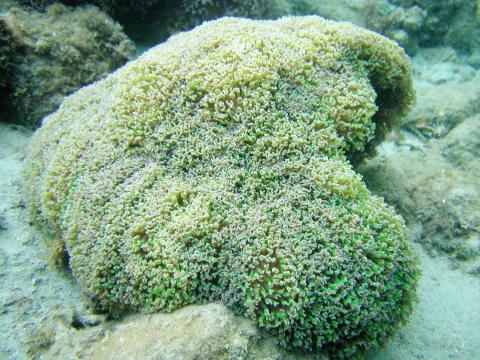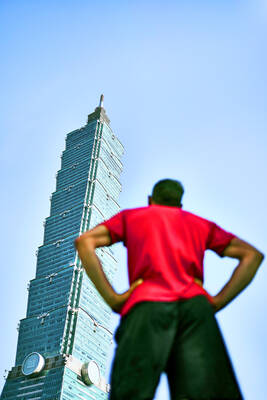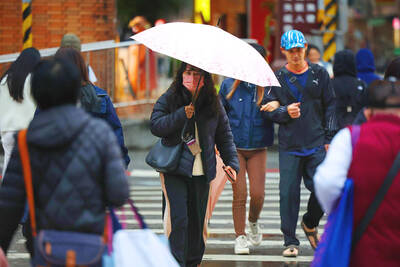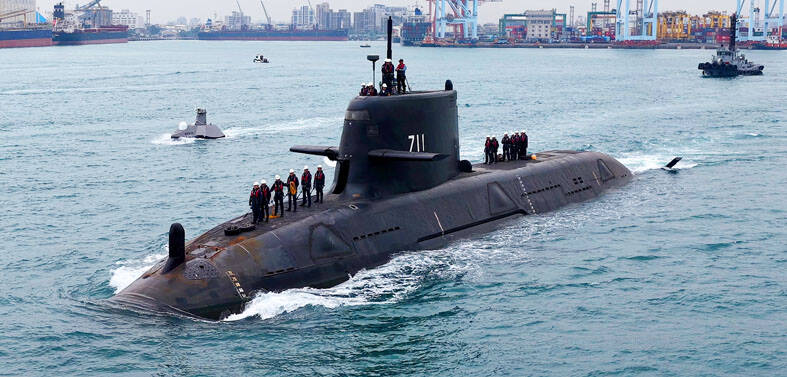Taiwanese and US marine biologists have solved a major scientific puzzle on the bioluminescent color changes seen during the life cycles of coral, and the findings might be used to find ways to protect human skin from damage by ultraviolet rays.
In a research collaboration between the National Museum of Marine Biology and Aquarium (NMMBA) and the Scripps Institute of Oceanography in San Diego, California, scientists found that coral fluorescence changes from green in larvae to cyan in adult colonies.
According to Fan Tung-yun (樊同雲), co-author of the research report, ultraviolet radiation is harmful to coral and leads to coral bleaching and can even kill reef colonies.

Photo courtesy of the National Museum of Marine Biology and Aquarium
Past studies determined that coral have fluorescent proteins in their cells, which absorb higher-energy light and emit fluorescent light in a lower energy field, but the changes in life development and its associated behavior had not yet been fully explained, Fan said.
For the collaboration, the museum harvested newborn stony coral larvae (Seriatopora hystrix) in waters off Kenting’s South Bay (南灣) and raised them in an aquarium.
The paper — titled Life History Changes in Coral Fluorescence and the Effects of Light Intensity on Larval Physiology and Settlement in Seriatopora hystrix — was co-authored by Fan and US counterparts, M.S. Roth and Dimitri Deheyn.
The scientists subjected newborn larvae, growing larvae and adult polyps to varying wavelengths of light radiation, including ultraviolet, blue and cyan-colored lights.
Results indicated that the change in fluorescence from green in larvae to cyan in adult colonies can be attributed to physiological traits, and the fluorescent protein is affected by environmental conditions, heat stress, as well as differences in light levels and wavelengths.
“The fluorescent proteins have a varying protective effect during the coral’s life cycle. It is likely correlated with the fact that planktonic larvae float near the ocean’s surface [and are more exposed to sunlight] while adult polyps are anchored on the seafloor at some depth [and are thus more protected],” Fan said.
“Our discovery might benefit research into the protection of human skin from ultraviolet radiation. Scientists may be able to develop new types of sun screens or protective suits to guard against solar radiation and offer people greater protection,” he added.

US climber Alex Honnold is to attempt to scale Taipei 101 without a rope and harness in a live Netflix special on Jan. 24, the streaming platform announced on Wednesday. Accounting for the time difference, the two-hour broadcast of Honnold’s climb, called Skyscraper Live, is to air on Jan. 23 in the US, Netflix said in a statement. Honnold, 40, was the first person ever to free solo climb the 900m El Capitan rock formation in Yosemite National Park — a feat that was recorded and later made into the 2018 documentary film Free Solo. Netflix previewed Skyscraper Live in October, after videos

NUMBERS IMBALANCE: More than 4 million Taiwanese have visited China this year, while only about half a million Chinese have visited here Beijing has yet to respond to Taiwan’s requests for negotiation over matters related to the recovery of cross-strait tourism, the Tourism Administration said yesterday. Taiwan’s tourism authority issued the statement after Chinese-language daily the China Times reported yesterday that the government’s policy of banning group tours to China does not stop Taiwanese from visiting the country. As of October, more than 4.2 million had traveled to China this year, exceeding last year. Beijing estimated the number of Taiwanese tourists in China could reach 4.5 million this year. By contrast, only 500,000 Chinese tourists are expected in Taiwan, the report said. The report

Temperatures are forecast to drop steadily as a continental cold air mass moves across Taiwan, with some areas also likely to see heavy rainfall, the Central Weather Administration (CWA) said. From today through early tomorrow, a cold air mass would keep temperatures low across central and northern Taiwan, and the eastern half of Taiwan proper, with isolated brief showers forecast along Keelung’s north coast, Taipei and New Taipei City’s mountainous areas and eastern Taiwan, it said. Lows of 11°C to 15°C are forecast in central and northern Taiwan, Yilan County, and the outlying Kinmen and Lienchiang (Matsu) counties, and 14°C to 17°C

STEERING FAILURE: The first boat of its class is experiencing teething issues as it readies for acceptance by the navy, according to a recent story about rudder failure The Hai Kun (海鯤), the nation’s first locally built submarine, allegedly suffered a total failure of stern hydraulic systems during the second round of sea acceptance trials on June 26, and sailors were forced to manually operate the X-rudder to turn the submarine and return to port, news Web site Mirror Daily reported yesterday. The report said that tugboats following the Hai Kun assisted the submarine in avoiding collisions with other ships due to the X-rudder malfunctioning. At the time of the report, the submarine had completed its trials and was scheduled to begin diving and surfacing tests in shallow areas. The X-rudder,